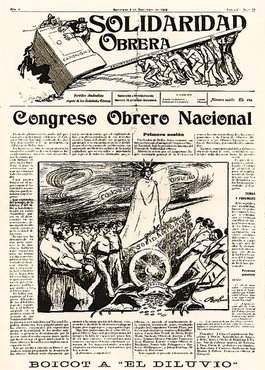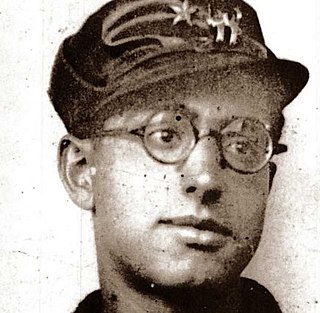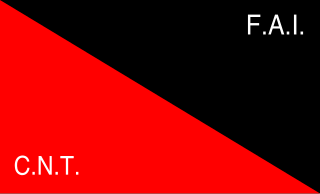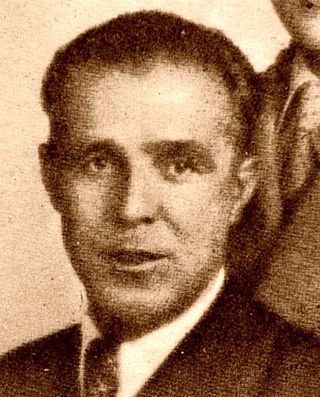
The Spanish Revolution was a workers' social revolution that began at the outbreak of the Spanish Civil War in 1936 and for two to three years resulted in the widespread implementation of anarchist and, more broadly, libertarian socialist organizational principles throughout various portions of the country, primarily Catalonia, Aragon, Andalusia, and parts of the Valencian Community. Much of the economy of Spain was put under worker control; in anarchist strongholds like Catalonia, the figure was as high as 75%. Factories were run through worker committees, and agrarian areas became collectivized and run as libertarian socialist communes. Many small businesses, such as hotels, barber shops, and restaurants, were also collectivized and managed by their workers.
Anarchism in Spain has historically gained some support and influence, especially before Francisco Franco's victory in the Spanish Civil War of 1936–1939, when it played an active political role and is considered the end of the golden age of classical anarchism.
The May Days, sometimes also called May Events, were a series of clashes between 3 and 8 May 1937 during which factions on the Republican side of the Spanish Civil War engaged one another in street battles in various parts of Catalonia, centered on the city of Barcelona.

Miguel García Vivancos was a Spanish Naïve painter and anarchist. He was a member of the National Confederation of Labor, during the Spanish Civil War he commanded several military units. With the defeat of the Republic he went into exile, where he developed a career as a painter. He was artistically known by his second surname.

The Iron Column was a Valencian anarchist militia column formed during the Spanish Civil War to fight against the military forces of the Nationalist Faction that had rebelled against the Second Spanish Republic.

Revolutionary Catalonia was the period in which the autonomous region of Catalonia in northeast Spain was controlled or largely influenced by various anarchist, communist, and socialist trade unions, parties, and militias of the Spanish Civil War era. Although the constitutional Catalan institution of self-government, the Generalitat of Catalonia, remained in power and even took control of most of the competences of the Spanish central government in its territory, the trade unions were de facto in command of most of the economy and military forces, which includes the Confederación Nacional del Trabajo which was the dominant labor union at the time and the closely associated Federación Anarquista Ibérica. The Unión General de Trabajadores, the POUM and the Unified Socialist Party of Catalonia were also prominent.

Solidaridad Obrera is a newspaper, published by the Catalan/Balearic regional section of the anarchist labor union Confederación Nacional del Trabajo (CNT), and mouthpiece of the CNT in Spain.

José Pellicer Gandía (1912–1942) was a Valencian anarchist revolutionary primarily known for commanding the Iron Column during the Spanish Civil War. Born into a well-off family, after the establishment of the Second Spanish Republic, Pellicer became an anarchist and joined the Confederación Nacional del Trabajo (CNT). He participated in a series of anarchist uprisings throughout the 1930s, establishing defence committees that set the foundation for the militias that would fight in the civil war. He co-founded the Iron Column, which pushed the Nationalists out of Valencia and into the province of Teruel, where he fought on the front lines. During the war, he came into conflict with the Communist Party of Spain (PCE), with the Servicio de Información Militar (SIM) arresting and imprisoning him. Despite this, he continued to fight in the Spanish Republican Army after the Iron Column's dissolution, as commander of the 83rd Mixed Brigade and later within the 109th Mixed Brigade. With the end of the war, he was captured and executed by the Francoist dictatorship.

Pepita Laguarda Batet (1919–1936), was a Catalan anarchist militiawoman who fought on the Aragon front during the Spanish Civil War. She was incorporated into the libertarian ranks without having yet reached adulthood and died in Uesca at the age of seventeen. She was the youngest soldier to die in combat during the war.

Ramón Rufat Llop (1916–1993) was a Spanish anarcho-syndicalist, agent of the Republican secret services, and anti-Franco fighter.

The confederal militias were a movement of people's militia during the Spanish Civil War organized by the Spanish anarchist movement: the National Confederation of Labor (CNT) and the Iberian Anarchist Federation (FAI). The CNT militias replaced clandestine defense committees instituted earlier. As the war progressed, the militias were progressively dissolved and assimilated into the Spanish Republican Army, in spite of many militiamen refusing the militarization.

Ricardo Sanz García (1898–1986) was a Valencian anarchist militant. A member of Buenaventura Durruti's insurgent group Los Solidarios, Sanz participated in the anarchist armed struggle against the Spanish monarchy and the dictatorship of Primo de Rivera. Following the proclamation of the Second Spanish Republic, he became a leader of the Confederación Nacional del Trabajo (CNT) and Federación Anarquista Ibérica (FAI) in Catalonia. During the Spanish Civil War, Sanz oversaw the training of the confederal militias and went on to lead the Durruti Column following the death of its namesake. In command of the Aragon front, he attempted multiple unsuccessful offensives against Zaragoza, but was either hampered by severe weather or held back by the Ministry of Defence. After the militarisation of the Column, he continued to command it as the reorganised 26th Division, but came into conflict with Communist-aligned commanders of the Spanish Republican Army. After the Nationalist victory in the Aragon Offensive, Sanz fled to France, where he remained for the rest of his life.
The Red and Black Column was the fifth militia column organized by the CNT-FAI in Barcelona to send to the Aragon front. Its incorporation took place in mid-September, in the Province of Huesca as a reinforcement to the anarchist Ascaso and Harriers columns.
The Land and Freedom Column was a militia column organized by the CNT-FAI from the regions of Berguedà and Bages as well as from Barcelona. The column was sent to the Central front in mid-September 1936 to reinforce the republican line against a nationalist force. It had around 1,500 militiamen in its beginnings. The column integrated into the Rosal Column and later fought on the Serra de Montsant front. After the militarization that occurred in the spring of 1937, the column became the 153rd Mixed Brigade.

The Central Committee of Antifascist Militias of Catalonia was an administrative body created on 21 July 1936 by the president of the Government of Catalonia, Lluís Companys, under pressure by the anarcho-syndicalists of the National Confederation of Labor (CNT) and Iberian Anarchist Federation (FAI), which led the workers' struggle against the July 1936 military uprising in Barcelona.

Gregorio Jover Cortés was an Aragonese anarcho-syndicalist and a member of the CNT during the first third of the 20th century. During the Spanish Civil War he was commander of the Ascaso Column and later the militarized 28th Division, which fought on the Aragon front.
Antonio García Birlán was an Andalusian anarchist based in Catalonia.
Antonio Ejarque Pina was an Aragonese anarchist.
The Brigade of Death was a unit of the confederal militias that acted at the beginning of the Spanish Civil War in the republican rear. Officially it was the investigation brigade of the South Ebro Column, a column of anarchist militiamen that Antonio Ortiz had led from Barcelona. Its leader was Pascual Fresquet and it was made up of some forty militiamen linked to the Barcelona Federación Anarquista Ibérica (FAI).
Nosotros was a Spanish anarchist militant group during the period of the Second Spanish Republic in the 1930s. The group was a reorganisation of Los Solidarios, a military group that had resisted the dictatorship of Primo de Rivera. After the proclamation of the Republic, Nosotros quickly came into conflict with the new government of Spain and provoked a number of insurrections during the early 1930s. Group members were deported following the Alt Llobregat insurrection of January 1932. The group, led by Joan Garcia Oliver, then incited the anarchist insurrection of January 1933. Following the 1933 Spanish general election, the group split over whether to carry out another insurrection, with Garcia Oliver calling for a focus on organisation, while Buenaventura Durruti went to Zaragoza to lead the anarchist insurrection of December 1933.










